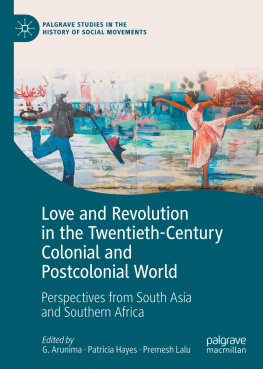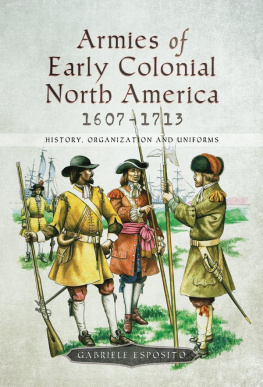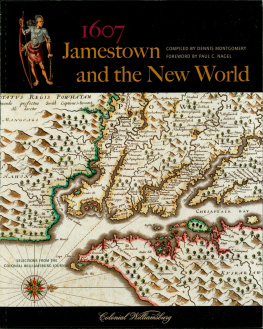University of Virginia Press
2018 by the Rector and Visitors of the University of Virginia
All rights reserved
Printed in the United States of America on acid-free paper
First published 2018
9 8 7 6 5 4 3 2 1
Library of Congress Cataloging-in-Publication Data
Names: Hantman, Jeffrey L., author.
Title: Monacan millennium : a collaborative archaeology and history of a Virginia Indian people / Jeffrey L. Hantman.
Description: Charlottesville : University of Virginia Press, 2018. | Includes bibliographical references and index.
Identifiers: LCCN 2018021464 | ISBN 9780813941479 (cloth : alk. paper) | ISBN 9780813941486 (e-book)
Subjects: LCSH: Monacan IndiansVirginiaHistory. | Monacan IndiansAntiquities.
Classification: LCC E99.M85 H36 2018 | DDC 975.5/01dc23
LC record available at https://lccn.loc.gov/2018021464
Cover art: Detail of Nova Virginiae Tabula, Petrus Kaerius, 1634. (Colonial Williamsburg Foundation, museum purchase)
ACKNOWLEDGMENTS
I have been honored to work with and write about the Monacan Indian people of Bear Mountain, Amherst County, Virginia. I worked with many members of the tribal council, with the chiefs, and with directors of the Monacan Ancestral Museum. I thank Chief Dean Branham and the current council members who allowed me to present drafts of this work for review. They talked about the importance of history to the Monacan people, and they encouraged me with their interest in my work. I am indebted to all.
The first person to welcome me to the community was Phyllis Hicks. The warmth and guidance she showed me from my first introduction to the tribe never wavered. Whenever I came to Bear Mountain I would stop by to see her in her office in the community center. Wed ask each other about family and compare notes on being busy. As I began to step away to work at the adjacent Monacan Ancestral Museum, I often thought Id skirted a certain topic: my progress on this very book. But Phyllis never let that topic slide. She would ask, Hows that book coming, Jeffrey? You get on that book, now. Its for the next generation. Phyllis took care of many, many responsibilities for the Monacan community and she knew just how to persuade others to honor what they had promised to do. Sadly, Reverend Phyllis Branham Hicks passed away in 2015. This book is dedicated to her. I hope Ive met her goals. They were, and are, ever present in my mind.
Former Monacan chief Sharon Bryant asked me some of the toughest and best questions about my work from our first meeting. Her questions are described within the book and they motivate my research to this day. I thank former chief Kenneth Branham who was always generous in his support over his long term as chief. I am very lucky to know the friendship of this humble and remarkable man. I learned also from the late George Whitewolf and the late Danny Red Elk Gear.
Diane Shields and Karenne Wood were the Monacan tribal historians when I first started to work with archival data, and we often worked side by side on issues of repatriation and documentation. Sue Elliott, Johnny Johns, and Brenda Garrison were always welcoming to me and interested in the archaeological work. Lou Parrish, niece of Phyllis Hicks, and Teresa Pollak, daughter of Diane Shields, continue to lead the next generation, and their recent support has meant a great deal to me. Thank you to Roy Hicks for allowing publication of the photograph of his wife, Phyllis Hicks, in this book. I apologize to any of my Monacan friends whom I have not mentioned by name.
Karenne Wood and I have worked together on many issues of concern to the Monacans and the Indian people of Virginia. Through Karennes invitations, I was able to participate in many sessions for educators, museum professionals, and university programs on the workings of collaborative history. Karenne earned her PhD in linguistic anthropology from the University of Virginia in 2016, studying language revitalization issues for the Monacan community. She is the program director of the Virginia Indian Heritage Program and has been a coauthor, student, teacher, political activist, and friend.
Most everyone in the Monacan community, and I, are indebted to Dr. Peter Houck, a Lynchburg pediatrician who provided a free clinic on Bear Mountain for many years. In his book Indian Island in Amherst County (1984), Dr. Houck was clear in drawing a connection from the present day to the historic Monacan people of the Virginia interior. A kind, committed, and soft-spoken Lynchburg native, Dr. Houck passed away in 2015. His encouragement in my first years of research with the Monacan community is deeply appreciated.
I thank Catherine Slusser, E. Randolph Turner, Keith Egloff, and Dave Hazzard of the Virginia Department of Historic Resources for helping me with my work at several stages, including aspects of the difficult path to repatriation. Helen C. Rountree, Stephen Potter, and William Kelso each shared freely their deep knowledge of the Chesapeake when I first looked into the Algonquian and Jamestown world. I know they will not all agree with my historical interpretations, but their prodigious efforts in the region were, and are, where much of my work begins.
I thank Deanna Beacham (Weapemeoc) for her support while she was director of the Virginia Council of Indians. I enjoyed many conversations with Sam Cook of Virginia Tech, who earned so much respect from the Monacan community. I am indebted to Dr. Linwood Custalow (Mattaponi) for the profound influence he had on me in discussions regarding oral history.
Many undergraduate field school students have hopefully learned a lot in the cornfields of the Piedmont uncovering Monacan history and working with collections in the Monacan museum. I appreciate their collective work. They were directed by some exceptional graduate student field supervisors, who were my teachers as well through the insights of their own work. I am indebted to every one of the following former archaeology graduate students at Virginia: Jennifer Aultman, Elizabeth Bollwerk, Gary Dunham, Michael Fedore, Martin Gallivan, Thomas Klatka, Michael Klein, Lisa Lauria, Adrienne Lazazzera, and Lynn Pietak. Debra Gold began work on this project as a Virginia undergraduate and went on to do her doctoral research on Monacan bioarchaeology at the University of Michigan. Bollwerk, Gallivan, Gold, Dunham, Klatka, and Klein all have published their Monacan studies in books and articles, and their work is cited extensively in the chapters that follow. They are my friends and colleagues now, and I am immensely proud of their prodigious and continuing contributions to archaeology, anthropology, and indigenous studies in the greater Chesapeake region and beyond.
In the Department of Anthropology at UVA I have been privileged to enjoy the friendship and support of Allison Alexy, Ira Bashkow, Ellen Contini-Morava, Eve Danziger, Lise Dobrin, Ravindra Khare, Charles Kaut, J. David Sapir, John Shepherd, Roy Wagner, and Kath Weston, as well as many others who are sadly no longer with us: James Deetz, Dell Hymes, Virginia Hymes, Charles Perdue, Nan Perdue, and Edith Turner. Susan McKinnon, Fred Damon, and Peter Metcalf, each of whose ethnographic fieldwork was conducted on the other side of the globe from Virginia, were always engaged, critical, and supportive, as needed, for which I am extremely grateful. Susan McKinnon read and commented on this manuscript, inspiring many nuanced and not-so-nuanced changes, and has been a friend and teacher in matters of kinship and hierarchy since the years we shared an office as assistant professors. To work with all of these people has been a gift, in every anthropological meaning of the word. I hope I have returned the gift in part. I am not weighed down but inspired by the debt I will continue to repay.







